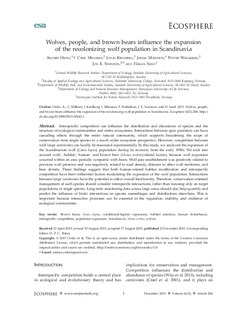Wolves, people, and brown bears influence the expansion of the recolonizing wolf population in Scandinavia
Ordiz, Andres; Milleret, Cyril; Kindberg, Jonas; Månsson, Johan; Wabakken, Petter; Swenson, Jon E.; Sand, Håkan
Original version
Ordiz, A., Milleret, C., Kindberg, J., Månsson, J., Wabakken, P., Swenson, J., & Sand, H. (2015). Wolves, people, and brown bears influence the expansionof the recolonizing wolf population in Scandinavia. Ecosphere, 6(12). 10.1890/ES15-00243.1Abstract
Interspecific competition can influence the distribution and abundance of species and the
structure of ecological communities and entire ecosystems. Interactions between apex predators can have
cascading effects through the entire natural community, which supports broadening the scope of
conservation from single species to a much wider ecosystem perspective. However, competition between
wild large carnivores can hardly be measured experimentally. In this study, we analyzed the expansion of
the Scandinavian wolf (
Canis lupus
) population during its recovery from the early 1990s. We took into
account wolf-, habitat-, human- and brown bear (
Ursus arctos
)-related factors, because wolf expansion
occurred within an area partially sympatric with bears. Wolf pair establishment was positively related to
previous wolf presence and was negatively related to road density, distance to other wolf territories, and
bear density. These findings suggest that both human-related habitat modification and interspecific
competition have been influential factors modulating the expansion of the wolf population. Interactions
between large carnivores have the potential to affect overall biodiversity. Therefore, conservation-oriented
management of such species should consider interspecific interactions, rather than focusing only on target
populations of single species. Long-term monitoring data across large areas should also help quantify and
predict the influence of biotic interactions on species assemblages and distributions elsewhere. This is
important because interactive processes can be essential in the regulation, stability, and resilience of
ecological communities
